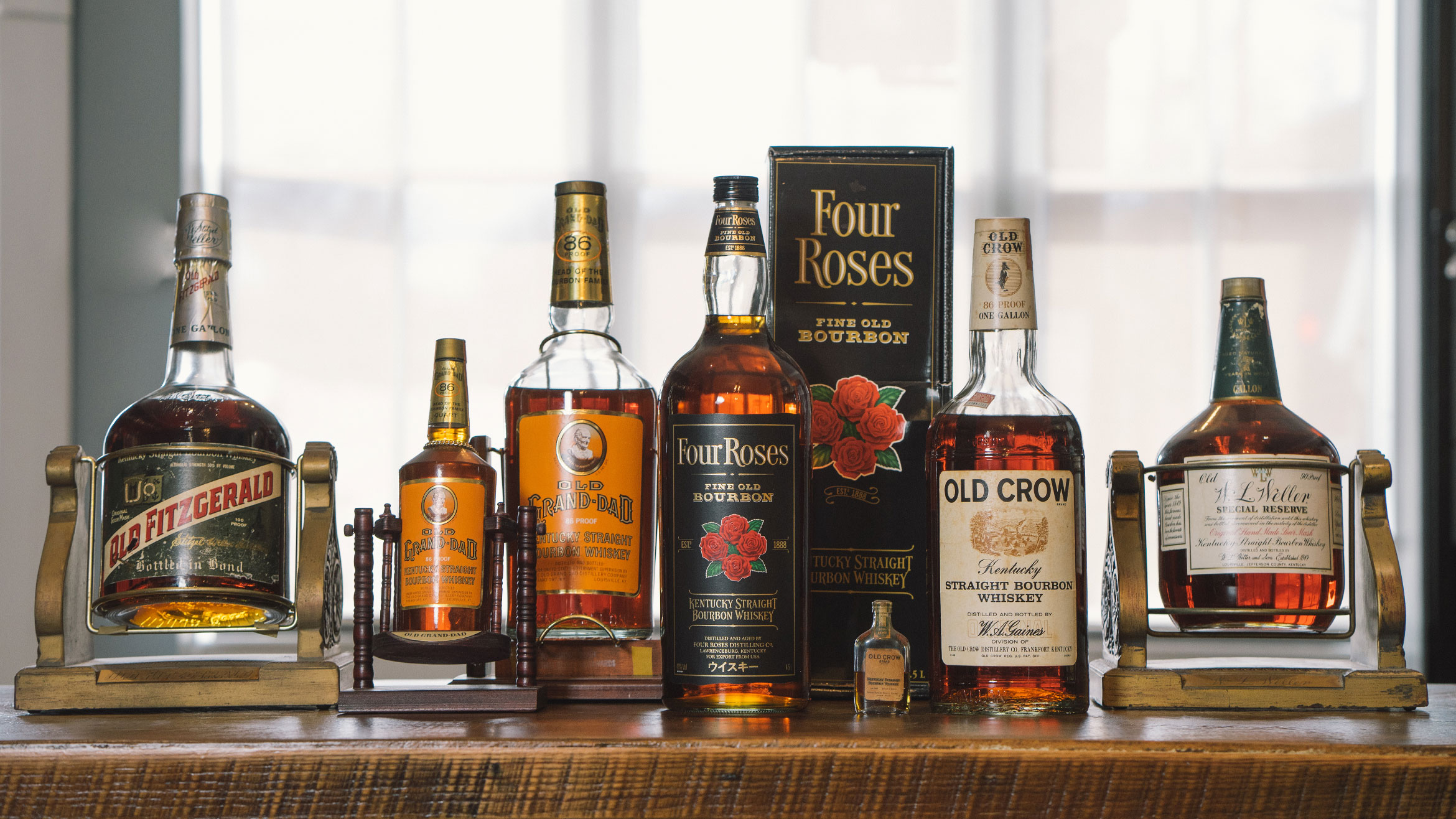Check TTB regulations closely and you’ll see there are only eight different bottle sizes liquor companies can legally sell to American consumers these days. That starts at the bottom with the 50-milliliter mini-bar “nip” and goes all the way up to the frat-friendly 1.75-liter “handle” size, which sounds reasonable enough. But in the 1960s and ’70s, that wasn’t the case. Back then, distilleries were not only producing, but were legally selling, enormous, gallon-sized vessels filled with bourbon.
“The big bottles don’t really have huge history behind them,” explains Justin Thompson. “They really were just used as a showy display.”
Thompson, the co-founder of the Bourbon Review and co-owner of Belle’s Cocktail House in Lexington, Kentucky, has been a longtime collector of vintage (and often strange) bottles of historic American whiskey. Last year, when a Kentucky House Committee passed legislation allowing for bars and restaurants to purchase vintage bottles from private collections, Thompson knew he had found his next business opportunity. Earlier this month, with friend and fellow collector Justin Sloan, he opened Justins’ House of Bourbon, a store that stocks perhaps the largest vintage bourbon collection in the entire world, with highlights including a 1919 Bond & Lillard and the famed Pappy Van Winkle “Green Glass.” But the real showstoppers, at least visually, are some of the gallon-plus sized bourbon bottles on display, a few of which stand nearly waist-high.
“It’s crazy some of these have survived so long,” says Sloan. “They’re definitely more rare than regular [dusty] bottles, but there’re more of them out there than you’d think, too.”
Thompson is generally right that there isn’t much history or even explicit reasoning behind these giant bottles, which have been illegal to package in since 1979. None of the major Kentucky distilleries I talked to could even point to the first one to be manufactured, nor could the Distilled Spirits Council of the United States. Sloan claims the earliest example he’s ever come across is a 1957 Jim Beam, and that seems about right. Much like oddball decanters, also started by Jim Beam, these big bottles emerged during bourbon’s midcentury “glut” era, perhaps in the hopes of moving excess product. (However, there are also examples of giant gin and Scotch bottles from the time.)
“They’re definitely more rare than regular [dusty] bottles,” says Sloan, “but there’re more of them out there than you’d think, too.”
If Jeroboams of wine make sense from a long-term aging and celebratory perspective, there are very few instances where you’d need so much bourbon in one place, at one time. Still, as Sloan explains, “A lot of bars ended up with them. It was probably just brands putting them behind the bar in the hopes of getting attention over [other brands’] smaller bottles.” He also points to the pouring apparatuses that came with the bottles, often cradles, as further proof that they were being used to actually serve people.
Although, quite a few of these bottles clearly weren’t being drunk by any one. “It’s crazy some of these have survived so long,” thinks Sloan.
Below, a few notable bottles from the Justins’ House of Bourbon collection of large-format bourbons.
Old Crow Gallon | 1964
The idea that these large-format bottles were merely bar showpieces is quickly dispelled when you see the Kansas tax stamp across the cap of this bottle, proof it was at one time actually sold to consumers in the state. From the Old Crow Distillery in Frankfort, bottled by W.A. Gaines and Co., Sloan calls it “usual suspect” Old Crow, meaning 86 proof and 4 years old.
Old Grand-Dad Gallon | Mid-1970s
This 86-proof “OGD” rests in a wooden cradle, which would have helped bartenders pour this cumbersome beast. Currently, Old Grand-Dad is owned by Beam-Suntory, but this is an example of National Distillers juice, some of the most ballyhooed dusty bourbon found on the secondary market. While drinking from any of these big boys would be a treat for most of us, Sloan casually notes that he’s tried them all—and particularly enjoyed this one.
Old Fitzgerald Gallon | 1972
This bottled-in-bond bourbon was distilled in 1968 at the famed Stitzel-Weller Distillery. Considered a bit of a bottom shelf pour these days—and now in Heaven Hill’s portfolio—back then it was under Pappy’s purview, and considered exceptional. The squat bottle comes with a metal-and-wood pouring cradle.
W.L. Weller Special Gallon | 1979
The crown jewel of the Justins’ House of Bourbon big-bottle collection is also courtesy of Stitzel-Weller. Bottled in the final year of the gallon bottles’ heyday, it’s no different than the standard Weller of the era, but such exemplary bourbon in such a large quantity obviously fetches a massive price amongst collectors: around $22,500 on today’s market.
Four Roses 4.5L | 1994
This extra-large Four Roses release proves distillers were still occasionally making bottles of this scale after 1979, but only for international customers. Produced as a promotional item for the Japanese market, Sloan speculates it might have just sat in a liquor store for a long time with nobody wanting it. He calls the juice inside “the start of what we know of Four Roses today.” He claims not to see a ton of the distillery’s straight bourbon from this era, making this bottle quite special.





